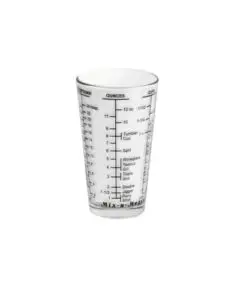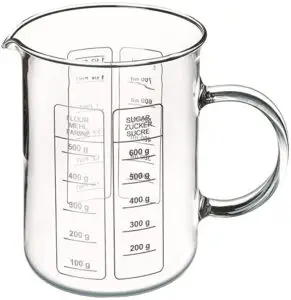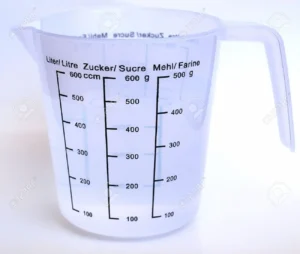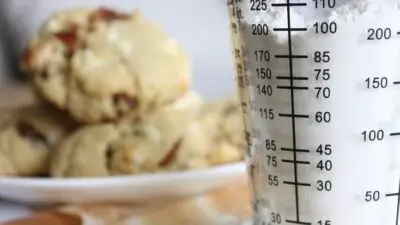If you’re wondering how many cups are 500 grams, you’re not alone. Converting between grams and cups can be tricky, especially in cooking and baking, where precision is key. Five hundred grams is a common measurement for many ingredients, such as flour, sugar, and butter.
Knowing how to convert this amount into cups can help you achieve the right consistency and flavor in your recipes. In this article, we’ll explore how to convert 500 grams to cups and provide you with some helpful tips for accurate measurement.
What is grams and cups?

Grams and cups are both units of measurement commonly used in cooking and baking. A gram is a metric unit of mass, equivalent to one-thousandth of a kilogram. It is often used to measure small quantities of ingredients, such as spices, yeast, or baking powder.
A cup, on the other hand, is a volume measurement typically used for liquids and dry ingredients. The exact size of a cup can vary depending on the country, with the United States and Canada using a different cup measurement than the metric system. In the US and Canada, a cup is equal to 240 milliliters or 8 fluid ounces, while in the metric system, a cup is equal to 250 milliliters.
When converting between grams and cups, it is important to keep in mind the specific ingredient being measured, as the density and weight of different ingredients can vary greatly.
Converting grams to cups and vice versa
Converting grams to cups and vice versa can be useful for adjusting recipes or measuring ingredients accurately. However, it’s important to note that the conversion factor can vary depending on the specific ingredient being measured.
To convert grams to cups, first determine the conversion factor for the specific ingredient. This can usually be found on the packaging or by doing a quick online search. For example, the conversion factor for all-purpose flour is typically 125 grams per cup. To convert 500 grams of flour to cups, divide 500 by 125, which equals 4 cups.
To convert cups to grams, again, use the conversion factor for the specific ingredient. For example, if the conversion factor for white sugar is 200 grams per cup, and you need 2 cups of sugar, multiply 2 by 200, which equals 400 grams.
It’s important to note that the conversion factor can vary for different types of ingredients, and it’s always best to check the specific conversion factor for the ingredient you measure to ensure accuracy. Additionally, using a kitchen scale to measure ingredients by weight is often the most precise method for achieving consistent results in cooking and baking.
Why do people need to convert between grams and cups
People need to convert between grams and cups for a variety of reasons when it comes to cooking and baking.
Firstly, different recipes may call for different measurements, with some recipes using cups while others use grams. Being able to convert between the two can help you follow recipes more accurately.
Secondly, using the wrong measurement can impact the outcome of a recipe. For example, using too much or too little of an ingredient can result in a cake that is too dry or too dense. By converting between grams and cups accurately, you can ensure that your recipes turn out just right.
Thirdly, measuring ingredients by weight in grams can be more precise than measuring by volume in cups. This is especially important for recipes that require exact measurements, such as bread making.
Lastly, people may need to convert between grams and cups when adjusting recipes for dietary needs or making smaller or larger batches of a recipe. Being able to accurately convert between grams and cups allows for more flexibility in the kitchen.
Importance of accurate measurement in cooking and baking
Accurate measurement is essential in cooking and baking for several reasons.
Firstly, using the right amount of ingredients is crucial for achieving the desired flavor and texture of a dish. For example, using too much salt can make a dish too salty, while using too little sugar can result in a bland dessert.
Secondly, accurate measurement ensures consistency in recipes. If the ingredients are not measured properly, the end result can vary from one batch to another, which can be especially problematic for commercial food production.
Thirdly, baking is a science that requires precise measurements. Baking recipes often call for specific ratios of ingredients, and deviations from these ratios can lead to disastrous results. For example, too much or too little leavening agent can cause a cake to collapse or fail to rise.
Lastly, measuring ingredients accurately is important for dietary reasons. Measuring ingredients by weight, for example, can be more precise than measuring by volume, which is particularly important for people following a specific diet or trying to manage their calorie intake.
How to convert 500 grams to cups

To convert 500 grams to cups, you will need to know the conversion factor for the specific ingredient you are measuring. The conversion factor varies depending on the ingredient, as the density of each ingredient is different.
For example, the conversion factor for all-purpose flour is typically 125 grams per cup. To convert 500 grams of flour to cups, divide 500 by 125. This results in 4 cups of all-purpose flour.
However, if you are measuring a different ingredient, the conversion factor will likely be different. For example, the conversion factor for granulated sugar is typically 200 grams per cup. In this case, to convert 500 grams of sugar to cups, divide 500 by 200, which equals 2.5 cups.
It’s important to note that the conversion factor can vary for different types of ingredients, so it’s always best to check the specific conversion factor for the ingredient you measure to ensure accuracy. Additionally, using a kitchen scale to measure ingredients by weight is often the most precise method for achieving consistent results in cooking and baking.
Common ingredients measured in grams and cups
Many ingredients in cooking and baking can be measured in both grams and cups. Here are some common ingredients and their approximate conversion factors:
- All-purpose flour: 125 grams per cup
- Granulated sugar: 200 grams per cup
- Brown sugar: 220 grams per cup
- Powdered sugar: 120 grams per cup
- Butter: 227 grams per cup
- Milk: 240 grams per cup
- Water: 240 grams per cup
- Rolled oats: 90 grams per cup
- Almonds (whole): 140 grams per cup
- Chocolate chips: 170 grams per cup
- Breadcrumbs (dry): 100 grams per cup
It’s important to note that these conversion factors are approximate and can vary slightly based on factors such as the moisture content and packing density of the ingredient. To ensure accuracy in recipes, it’s best to use a kitchen scale to measure ingredients by weight whenever possible. However, if a scale is not available, measuring cups can be used with reasonable accuracy as long as the appropriate conversion factor is used.
Differences between US and metric cup measurements
There are two main cup measurements used in cooking and baking: the US cup and the metric cup. While they are both called “cups,” they are not the same volume, which can lead to confusion when using recipes from different regions or countries.
The US cup is the most commonly used cup measurement in North America and is equal to 240 milliliters (ml) or 8 fluid ounces (fl oz). It is often used to measure liquid ingredients such as water, milk, and oil, as well as dry ingredients such as flour and sugar.
On the other hand, the metric cup is used in most other countries and is equal to 250 ml or 8.45 fl oz. It is typically used to measure dry ingredients such as flour, sugar, and spices, as well as liquid ingredients such as milk and cream.
The difference between the two cup measurements may not seem significant, but it can make a difference in the outcome of a recipe, especially when using larger quantities of ingredients. To avoid confusion, it’s important to check the specific cup measurement being used in a recipe and to convert between the two if necessary.
It’s also worth noting that some ingredients, such as butter and chocolate, are often measured in grams or ounces rather than cups, as their density can vary significantly. It’s always best to consult a reliable recipe or conversion chart when measuring ingredients for cooking and baking.
Importance of measuring ingredients by weight for precision
Measuring ingredients by weight is considered the most precise and accurate way to measure ingredients in cooking and baking. This is because weight is a more reliable indicator of the quantity of an ingredient than volume, which can be affected by factors such as packing density, humidity, and temperature.
When a recipe calls for a certain weight of an ingredient, using a kitchen scale to measure the exact amount is essential to ensure consistency and accuracy. This is particularly important in baking, where even small variations in the number of ingredients can have a significant impact on the final result.
For example, if a recipe calls for 500 grams of flour, but the volume of the flour is measured using a cup, the actual amount of flour used may be more or less than 500 grams, depending on the density of the flour and how it is packed into the cup. This can result in a finished product that is either too dry or too moist, affecting its texture and flavor.
Using weight measurements also allows for easier scaling of recipes. If a recipe needs to be doubled or halved, for example, it’s much easier to calculate the appropriate amounts of each ingredient using weight measurements than it is with volume measurements.
Overall, measuring ingredients by weight is a reliable and precise method that can help ensure consistent and delicious results in cooking and baking.
Tips for measuring ingredients accurately

Measuring ingredients accurately is essential to achieving consistent results in cooking and baking. Here are some tips for measuring ingredients accurately:
- Use the appropriate measuring tools: Use a dry measuring cup for dry ingredients and a liquid measuring cup for liquids. For small quantities, use measuring spoons.
- Level off dry ingredients: When measuring dry ingredients such as flour, sugar, or cocoa powder, use a straight-edged utensil, like the back of a knife, to level off the ingredient in the measuring cup or spoon. This ensures that you have the right amount of ingredients.
- Fill liquid measuring cups to the right line: Pour the liquid into a liquid measuring cup on a flat surface, and then check the level at eye level.
- Tare the scale: If using a kitchen scale, make sure to “tare” it before adding the ingredient. This means resetting the scale to zero after placing the measuring container on it so that the weight of the container is not included in the measurement.
- Use weight measurements: Whenever possible, use weight measurements for accuracy and consistency.
- Don’t pack ingredients: For most ingredients, don’t pack them tightly into the measuring cup or spoon, as this can result in more than the intended amount.
- Be consistent: Use the same measuring tools and techniques each time to ensure consistent results.
By following these tips, you can measure ingredients accurately and achieve consistent and delicious results in your cooking and baking.
Measuring cups vs. kitchen scales: which one to use?
When it comes to measuring ingredients, there are two main tools that are commonly used: measuring cups and kitchen scales. Each has its own advantages and disadvantages, and which one to use depends on the type of recipe and personal preference.
Measuring cups are typically used to measure dry ingredients like flour, sugar, and oats, as well as liquids like milk and water. They are easy to use and require minimal clean-up. Measuring cups are also more affordable than kitchen scales and don’t require batteries or electricity. However, measuring cups may not always provide the most accurate measurement, as the number of ingredients can be affected by how it is packed into the cup.
Kitchen scales, on the other hand, measure ingredients by weight, which is often more accurate and precise than measuring by volume. This is especially important in baking, where small variations in ingredient measurements can have a big impact on the final product. Kitchen scales are also versatile, as they can be used to measure a variety of ingredients, including dry, liquid, and even whole foods like fruits and vegetables.
However, kitchen scales can be more expensive than measuring cups and require batteries or electricity to function. They also require a bit more clean-up, as ingredients must be weighed in a container and then transferred to the mixing bowl or cooking pot.
Overall, both measuring cups and kitchen scales have their advantages and disadvantages. If precision and accuracy are essential, a kitchen scale may be the better choice. For quick and easy measuring or for recipes that don’t require exact measurements, measuring cups may be sufficient. Ultimately, the choice between measuring cups and kitchen scales will depend on the specific recipe and the cook’s personal preference.
How to adjust recipes when measuring ingredients by weight or volume
When measuring ingredients for a recipe, it is important to use the same measurement units throughout to ensure accurate and consistent results. If a recipe calls for ingredients to be measured by weight, but you only have measuring cups, or vice versa, there are a few ways to adjust the recipe.
If the recipe calls for measuring by weight, but you only have measuring cups:
- Look up the ingredient’s weight-to-volume conversion factor online or in a cookbook.
- Measure out the ingredient using the measuring cup and then convert the volume to weight using the conversion factor.
For example, if the recipe calls for 500 grams of flour, but you only have measuring cups, you could look up the conversion factor (1 cup of flour = 125 grams) and measure out 4 cups of flour instead.
If the recipe calls for measuring by volume, but you only have a kitchen scale:
- Look up the ingredient’s volume-to-weight conversion factor online or in a cookbook.
- Weigh the ingredient using the kitchen scale and then convert the weight to volume using the conversion factor.
For example, if the recipe calls for 2 cups of sugar, but you only have a kitchen scale, you could look up the conversion factor (1 cup of sugar = 200 grams) and weigh out 400 grams of sugar instead.
It is important to note that these conversions may not always be exact and can vary depending on factors such as humidity, temperature, and the density of the ingredient. Adjustments may need to be made based on personal experience and preference.
In general, it is recommended to measure ingredients by weight for the most precise and consistent results, especially in baking. However, measuring by volume can still yield satisfactory results for many recipes.
Conclusion
If you want to find out how many cups are 500 grams, then we have you covered here. Knowing how to convert between grams and cups is an essential skill for anyone who enjoys cooking and baking. While measuring by weight is generally considered more accurate, measuring by volume can still yield good results.
When converting 500 grams to cups, the exact conversion may vary depending on the ingredient and the measurement system used. By following the tips and guidelines discussed above, you can ensure that your recipes turn out consistently delicious every time.

